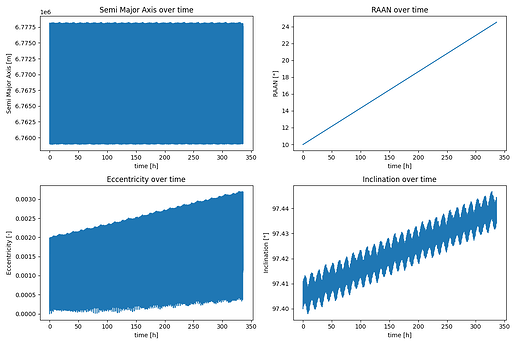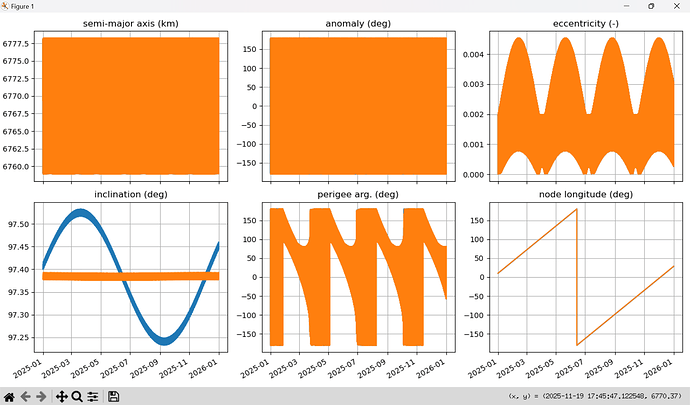Hello,
I am relatively new to orekit. I am propagating a circular sun-synchronous orbit with a numerical propagator and Holmes-Featherstone Attraction Model using the Orekit Python Wrapper. Here is the important parts of my code :
#Circular orbit, initialized with Keplerian parameters
ra = 400 * 1000 # Apoapsis (km)
rp = 400 * 1000 # Periapsis (km)
inclination = radians(97.4)
argument_of_perigee = radians(0.00)
raan = radians(10.00)
mean_anomaly = radians(0.00)
semi_major_axis = (rp + ra + 2 * equatorial_earth_radius) / 2.0
eccentricity = 1.0 - (rp + equatorial_earth_radius) / semi_major_axis
epoch_orbital_parameters = simulation_start_datetime
initial_kepler_orbit = KeplerianOrbit(
semi_major_axis, # semi-major axis in m
eccentricity, # eccentricity 0 to 1
inclination, # inclination rad
argument_of_perigee, # perigee argument rad
raan, # raan rad
mean_anomaly, # anomaly rad
PositionAngleType.MEAN, # type of anomaly -> MEAN
EME2000_frame, # parameter frame
epoch_orbital_parameters, # date of orbital parameters
mu_m3_s2, # mu m^3/s^2
)
#Integrator
integrator = DormandPrince853Integrator(
step_size / 10, # minimum time step
step_size, # maximum time step
1.0e-10, # relative tolerance
1.0e-10, # absolute tolerance
)
#define propagator
propagator = NumericalPropagator(integrator)
propagator.setOrbitType(OrbitType.CIRCULAR)
#add gravity model
gravity_field = GravityFieldFactory.getNormalizedProvider(70, 70)
gravity_model = HolmesFeatherstoneAttractionModel(itrf_frame, gravity_field)
propagator.addForceModel(gravity_model)
When I propagate for a time span of two weeks, I get these results for a few orbital parameters:
The RAAN and semi major axis behave as expected.
However, eccentricity and inclination increase in a linear way (apart from the oscillation), although I would expect them to stay constant. I am wondering wether the deviation is caused by a numerical error or if my code for the orbit definition is wrong.
Many thanks
Marvin

